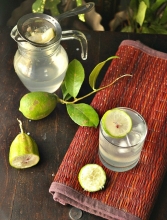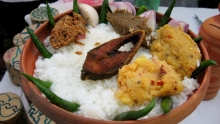The less social, more attractive cousin of kaffir lime, Gondhoraj lebu is eastern India’s best-kept aromatic secret
For Purabi Dasgupta, who left her childhood home in ‘east Bengal’ (Bangladesh) and moved to Calcutta in 1946, the most enduring memory of life in Barisal is neither about the silver hilsas nor the fleshy coconuts felled by nor’westers—but the scent of gondhoraj lebu. She remembers infusing the magic of this parrot-green lime, literally the ‘king of aromas’, into her panta bhaat—a summer staple of water-soaked rice—and how it put to shame the parallel forces of salt, onion and green chillies that the dish is served with.
Years later, as she instructs her daughters-in-law to be generous in squeezing the lebu juice into mishri pani, the world still fumbles to tell it apart from its media-savvy kin, kaffir lime. With no official English name, or so much as a Wikipedia entry, it is fair to think of the gondhoraj as a headstrong hipster, too cool to ask for your company.
Restaurateur Anjan Chatterjee would agree. He explains how this lovechild of mandarin orange and common lime, originally called ‘Rangpur lime’, after its birthplace in east Bengal, refuses to grow anywhere beyond the east coast. “Many have tried, but it’s of no use,” he says, not sounding one bit heartbroken. And that makes you imagine the lime as an extension of the traditional Bengali arsenal of poetry, Marxism and poetic-scepticism—you might share their quest for that stuff, but you’d never own it.
Chatterjee’s restaurant Oh! Calcutta is known for its gondhoraj bhetki, a dish of steamed Asian sea bass in lime and coconut gravy. He describes gondhoraj as one with a “fruitier, crispier, perhaps sharper note” compared to the more rounded scent of a regular nimbu. Gondhoraj lebu can be used to accentuate the original flavour of just about anything. Apparently, this lime can turn dreamy your humble lassi, romance kitchen elements like black cumin, coconut, mustard and green chilli with equal flourish and play companion to urad dal, kosha mangsho (spicy mutton curry) and various fish curries. “It is widely used with gin, vodka and shandy,” he rattles off, vouching for friends, who as young teetotallers “almost turned alcoholic after having shandy made with gondhoraj lebu”.

Leaves of gondhoraj lebu add flavour and fragrance to fish curries. (Sayantani Mahapatra Mudi)
As Chatterjee wonders “how the lime would taste with a cup of black tea”, food-lover Purnendu Bose, who recently set up his probashi (migrant Bengali) restaurant Iti in Mumbai, recalls other pompless associations of gondhoraj. “Fine-grain rice—steaming hot—with a good serving of golden moong dal, crispy potato fries and gondhoraj lime is that happy refuge in my head,” he gushes, quite possibly speaking for the larger part of the Bengali populace. For him, the tranquil aroma of the lime brings back all things uncomplicated—Ma’s lunches before school and long Sunday siestas. In fact, Bose’s restaurant often witnesses the nostalgia that weaves itself around the citrus notes of this fruit. “We serve gondhoraj lebu complimentary and I’ve seen fathers watching over excitedly as their de-Bengalied kids inhale what for these grown men is a natural extension of their roots,” he smiles.
Kolkata’s phuchka, distinguished by its riot of flavours, is also indebted to the gondhoraj. Food blogger Rupsa Munsi, who fell in love with the lime as a little girl “queuing up at the phuchka wala’s stall in South Kolkata” rummages out a rather interesting recipe of gondhoraj chicken. Cooked to perfection with green chillies, onion and garlic paste, it uses the gondhoraj juice and gondhoraj zest to soften the dominant scent of garlic and onion.
That’s another thing, you could use almost any part of the lime. “The instruction was to throw in the leaf for aroma, but I improvised with the zest,” says Munsi, who decided to pull off the dish when her precious limes, sourced second-hand from Kolkata, started drying up as she failed to exhaust the stock after days of juicing them into every dal and vegetable.
Clearly, there are two kinds of Bengalis living outside the state—ones who try to coax foreign soil into bearing their beloved lime, as Chatterjee says, in vain—and others like Munsi, who source it, squeeze it, draw inspiration from it and then mourn its unavailability till another generous relative comes visiting.

The simple panta bhaat, generally eaten with chillies and onion, is delicious with the lime. Tahmid Munaz
“The gondhoraj has huge potential. Marketed right, it would give the gourmet world something to be excited about,” reckons Chatterjee, quickly adding that only scientific intervention may be able to simulate the soil and weather conditions that breathe life into this mysterious fruit. “The three gondhoraj trees I had in my garden in South Kolkata would produce 12-15 limes a year, so you can imagine the challenge,” he finishes off. Dasgupta, for her part, reminisces about a time when “house-help would sometimes clean utensils with the lime, there would be so many of them”.
It makes one wonder what other stories lie beneath the dark skin of this lime—hard to find, so much harder to forget.
![submenu-img]() IND vs SL, 1st T20I: Predicted playing XIs, live streaming details, weather and pitch report
IND vs SL, 1st T20I: Predicted playing XIs, live streaming details, weather and pitch report![submenu-img]() Women's Asia Cup 2024: India beat Bangladesh by 10 wickets to reach ninth successive final
Women's Asia Cup 2024: India beat Bangladesh by 10 wickets to reach ninth successive final![submenu-img]() Apple reduces prices of iPhones across models, iPhones 13, 14 and 15 will be cheaper by Rs...
Apple reduces prices of iPhones across models, iPhones 13, 14 and 15 will be cheaper by Rs...![submenu-img]() 'Elon Musk treated me badly for...,' says Tesla chief's daughter Vivian Jenna Wilson
'Elon Musk treated me badly for...,' says Tesla chief's daughter Vivian Jenna Wilson![submenu-img]() Watch video: 'Questionable' Indian food served to employees in Dutch office; Internet reacts
Watch video: 'Questionable' Indian food served to employees in Dutch office; Internet reacts![submenu-img]() Meet woman, a doctor who cleared UPSC exam to become IAS officer, resigned after 7 years due to...
Meet woman, a doctor who cleared UPSC exam to become IAS officer, resigned after 7 years due to...![submenu-img]() Meet IAS officer, one of India's most educated men, who earned 20 degrees, gold medals in...
Meet IAS officer, one of India's most educated men, who earned 20 degrees, gold medals in...![submenu-img]() Meet Maths genius, who worked with IIT, NASA, went missing suddenly, was found after years..
Meet Maths genius, who worked with IIT, NASA, went missing suddenly, was found after years..![submenu-img]() Meet Indian genius who fled to Delhi from Pakistan, worked at two IITs, awarded India’s top science award for…
Meet Indian genius who fled to Delhi from Pakistan, worked at two IITs, awarded India’s top science award for…![submenu-img]() Meet woman who cracked UPSC exam after accident, underwent 14 surgeries, still became IAS officer, she is...
Meet woman who cracked UPSC exam after accident, underwent 14 surgeries, still became IAS officer, she is...![submenu-img]() 5 Men Rape Australian Woman In Paris Just Days Ahead Of Olympic | Paris Olympics 2024
5 Men Rape Australian Woman In Paris Just Days Ahead Of Olympic | Paris Olympics 2024![submenu-img]() US Elections: 'I Know Trump's Type', Says Kamala Harris As She Launches Election Campaign
US Elections: 'I Know Trump's Type', Says Kamala Harris As She Launches Election Campaign![submenu-img]() Breaking! Nepal Plane Crash: Saurya Airlines Flight With 19 On Board Crashes In Kathmandu
Breaking! Nepal Plane Crash: Saurya Airlines Flight With 19 On Board Crashes In Kathmandu![submenu-img]() J&K Encounter: Search Operation By Indian Army, Police Continue, 1 Terrorist Neutralised In Kupwara
J&K Encounter: Search Operation By Indian Army, Police Continue, 1 Terrorist Neutralised In Kupwara![submenu-img]() Breaking! Nepal Plane Crash: Saurya Airlines Flight With 19 On Board Crashes In Kathmandu
Breaking! Nepal Plane Crash: Saurya Airlines Flight With 19 On Board Crashes In Kathmandu![submenu-img]() NASA images: 7 mesmerising images of space will make you fall in love with astronomy
NASA images: 7 mesmerising images of space will make you fall in love with astronomy![submenu-img]() 8 athletes with most Olympic medals
8 athletes with most Olympic medals![submenu-img]() In pics: Step inside Jalsa, Amitabh Bachchan, Jaya Bachchan's Rs 120 crore mansion with gym, jacuzzi, aesthetic decor
In pics: Step inside Jalsa, Amitabh Bachchan, Jaya Bachchan's Rs 120 crore mansion with gym, jacuzzi, aesthetic decor![submenu-img]() Remember Paul Blackthorne, Lagaan's Captain Russell? Quit films, did side roles in Hollywood, looks unrecognisable now
Remember Paul Blackthorne, Lagaan's Captain Russell? Quit films, did side roles in Hollywood, looks unrecognisable now![submenu-img]() This actor was called next superstar, bigger than Amitabh, Vinod Khanna, then lost stardom, was arrested for wife's...
This actor was called next superstar, bigger than Amitabh, Vinod Khanna, then lost stardom, was arrested for wife's...![submenu-img]() Meet man, tribal who tipped off Army about Pakistani intruders in Kargil, awaits relief from govt even after...
Meet man, tribal who tipped off Army about Pakistani intruders in Kargil, awaits relief from govt even after...![submenu-img]() Puja Khedkar case latest update: Shocking details about her parents Manorama Khedkar, Dilip Khedkar revealed
Puja Khedkar case latest update: Shocking details about her parents Manorama Khedkar, Dilip Khedkar revealed![submenu-img]() Kargil Vijay Diwas Live Updates: PM Modi visits Dras to mark 25th anniversary of Kargil Vijay Diwas
Kargil Vijay Diwas Live Updates: PM Modi visits Dras to mark 25th anniversary of Kargil Vijay Diwas![submenu-img]() Big rejig in BJP: New state chief for Bihar and Rajasthan named
Big rejig in BJP: New state chief for Bihar and Rajasthan named![submenu-img]() Mumbai rains: Schools, colleges to operate normally today, BMC urges citizens to...
Mumbai rains: Schools, colleges to operate normally today, BMC urges citizens to...![submenu-img]() DRDO fortifies India's skies: Phase II ballistic missile defence trial successful
DRDO fortifies India's skies: Phase II ballistic missile defence trial successful![submenu-img]() Gaza Conflict Spurs Unlikely Partners: Hamas, Fatah factions sign truce in Beijing
Gaza Conflict Spurs Unlikely Partners: Hamas, Fatah factions sign truce in Beijing![submenu-img]() Crackdowns and Crisis of Legitimacy: What lies beyond Bangladesh's apex court scaling down job quotas
Crackdowns and Crisis of Legitimacy: What lies beyond Bangladesh's apex court scaling down job quotas![submenu-img]() Area 51: Alien testing ground or enigmatic US military base?
Area 51: Alien testing ground or enigmatic US military base?![submenu-img]() Transforming India's Aerospace Industry: Budget 2024 and Beyond
Transforming India's Aerospace Industry: Budget 2024 and Beyond![submenu-img]() Chalti Rahe Zindagi review: Siddhant Kapoor's relatable but boring lockdown drama can be skipped
Chalti Rahe Zindagi review: Siddhant Kapoor's relatable but boring lockdown drama can be skipped ![submenu-img]() 'This is nothing but...': Pahlaj Nihalani on CBFC's delay in censor certification of John Abraham's Vedaa
'This is nothing but...': Pahlaj Nihalani on CBFC's delay in censor certification of John Abraham's Vedaa ![submenu-img]() Does Janhvi Kapoor pay for social media praise, positive comments? Actress reacts, 'itna budget...'
Does Janhvi Kapoor pay for social media praise, positive comments? Actress reacts, 'itna budget...'![submenu-img]() Parineeti Chopra's cryptic post about 'throwing toxic people out of life' scares fans: 'Stop living for...'
Parineeti Chopra's cryptic post about 'throwing toxic people out of life' scares fans: 'Stop living for...'![submenu-img]() Highest grossing animated film ever has earned Rs 12200 crore; beat The Lion King, Toy Story, Frozen, Minions, Shrek
Highest grossing animated film ever has earned Rs 12200 crore; beat The Lion King, Toy Story, Frozen, Minions, Shrek![submenu-img]() Watch video: 'Questionable' Indian food served to employees in Dutch office; Internet reacts
Watch video: 'Questionable' Indian food served to employees in Dutch office; Internet reacts![submenu-img]() This small nation is most important country in world, plays huge role in shaping geopolitics, it is...
This small nation is most important country in world, plays huge role in shaping geopolitics, it is...![submenu-img]() El Mayo in US custody: Who is Mexican drug lord Ismael Zambada, Sinaloa cartel leader arrested with El Chapo's son?
El Mayo in US custody: Who is Mexican drug lord Ismael Zambada, Sinaloa cartel leader arrested with El Chapo's son?![submenu-img]() Viral video: 15-foot python attacks and nearly swallows Jabalpur man, here's how locals save him, watch
Viral video: 15-foot python attacks and nearly swallows Jabalpur man, here's how locals save him, watch![submenu-img]() 'Anant knows everything': Akash Ambani, Isha Ambani tell Amitabh Bachchan as…
'Anant knows everything': Akash Ambani, Isha Ambani tell Amitabh Bachchan as…













































)
)
)
)
)
)
)
)
)
)
)
)
)
)
)






)
)
)
)
)
)